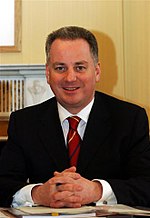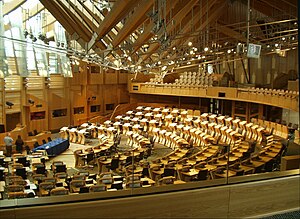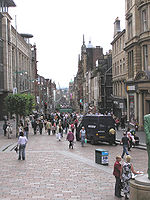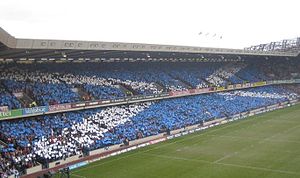Scotland
Template:Infobox UK nation Template:About
Scotland (Template:Lang-gd) is One of the four constituent countries of the United Kingdom.[1] Located in the North West of Europe, Scotland occupies the northern third of the island of Great Britain and over 790 neighbouring islands.[2] Surrounded on three sides by seas, the country has only one land border, to the south, with England.
The country's capital is the city of Edinburgh. It is the second largest city, after Glasgow, and one the largest financial centres in Europe.[3] Scotland's largest city is Glasgow, which is the centre of the Greater Glasgow conurbation. Greater Glasgow is home to approximately 40% of Scotland's population. Scottish waters consist of a large sector[4] of the North Atlantic, North Sea, North Channel and Irish Sea. These waters contain the largest oil reserves in the European Union.
The Kingdom of Scotland was once an independent state. The Union of the Crowns in 1603 and later the union of Parliaments with the England on 1 May 1707 created the United Kingdom of Great Britain and Northern Ireland and Scotland ceased to be an sovereign nation state. Scotland's legal system, Education system and Church remain separate from those of England Wales and and Northern Ireland. Their continued independence have been the cornerstones for the continuation of Scottish culture and Scottish national identity since the Union.
History
Early civilisation
Prior to the Mesolithic period, Scotland was repeatedly glaciated. The ice covered the entire land mass of Scotland and so has destroyed any evidence of early human habitation. The earliest Scottish human settlement, dated to around 8500 BC,[5] was found at Cramond, near Edinburgh.
A well preserved Neolithic farmstead can been seen at Knap of Howar on Orkney. The building, dated to around 3500 BC, is claimed to be the oldest standing house in the country.[6] An example of a complete Neolithic village can be seen nearby at the village of Skara Brae, on the Mainland of Orkney. There are many other Neolithic habitation, burial and ritual sites across Scotland such as: Callanish on Lewis, Maeshowe and The Ring of Brodgar on Orkney, and on the mainland of Scotland — the remains of early crannogs and Neolithic round houses are a common.
After the 8th century BC, Brythonic Celtic culture and language spread into Scotland. The Iron age brought numerous hill forts, brochs, crannogs and fortified settlements. These constructions had as much to do with a show of status and power as they did with warfare.
The only surviving pre-Roman account of Scotland originated with the Greek Pytheas of Massalia who circumnavigated the British islands (which he called Pretaniké) in 325 BC, but the record of his visit dates from much later.
Roman Scotland
The first detailed written histories of Scotland began with the arrival of the Roman Empire. In 43 the Romans invaded Britain. They quickly advanced into what is now England and Wales. Gradually, Roman control moved north into the Southern areas of modern Scotland. Gnaeus Julius Agricola became Governor of Britain in 77[7]. He was determined to conquer the whole of the Island. In 79, Agricola launched a military campaign into the Highlands of Scotland. Construction of a large fortress was started, but never completed, at Inchtuthil. In 84 Agricola fought the Caledonian tribes at the Battle of Mons Graupius. Though he won this battle, he never fully subdued the north of Scotland. The fortifications of the Gask Ridge in Perthshire in an attempt consolidate the Roman presence. However, after Agricola had been recalled to Rome in 85, forts these were all abandoned within few years.
The construction of Hadrian's Wall, between the Solway firth and Newcastle on Tyne, marked the first drawing of a border between what would become Scotland and England. Far from being a remote and war ravaged frontier, the lands immediately to the North of the wall were, for the most part, pro Roman and peaceful. Shortly after the walls construction, the Emperor Antonine came to power. He advanced the frontier and build, in the year 142, a second wall between the Firths of Cylde and Forth — known as Antonine's Wall. This wall was maned for only 24 years before the Romans reverted to Hadrian's Wall again in 164. Emperor Septimius Severus, in 204, briefly re-occupied the Antonine wall but the frontier retreated again after only a few years. In the late 4th century, there was a general decline of the Roman Empire and it's influence on Britain. By 410, the Roman administration and its legions were gone, leaving Britain to look to its own affairs.
Mediaeval
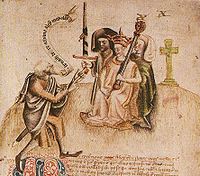
Pictland became dominated by the Pictish sub-kingdom of Fortriu. The Gaels of Dál Riata settled the region of Argyll. According to legend, the Scottish Saltire flag was adopted by King Óengus II of Fortriu in 832 after a victory over the Northumbrians at Athelstaneford. In 843 Cináed mac Ailpín (King Kenneth Macalpine) from Dál Riata, united the Kingdom of Scotland when he became the King of the Picts and Scots.
In the 10th and 11th centuries, the Kingdom of Scotland had comparatively good relations with the Wessex rulers of England. The period was marked by intense internal dynastic disunity, despite this, Scotland had relatively successful expansionary policies. The Kingdom of Strathclyde was handed over to King Malcolm I by King Edmund of England after an Edmund invaded in 945.[8] Around the year 960 and during the reign of King Indulf, the Scots captured the town of Eden which is now called Edinburgh.[9] The reign of Malcolm II saw fuller incorporation of these territories. A critical yearTemplate:Fact was 1018, when Malcolm II defeated the Northumbrians at the Battle of Carham.[10]
Norman Conquest of England in 1066 sent off ripples that were to have significant consequences for the Kingdom of Scotland. Malcolm III married Margaret who was the sister of Edgar Ætheling — one of the deposed Anglo-Saxon claimants to the English throne. Margaret played a major role in reducing the influence of Celtic Christianity and pulling the Scottish Church back towards the Papacy. Scotland went through something of its own "Norman Conquest" When David I became King. David I had become an important Anglo-Norman lord through marriage and was the Uncle of the Empress Matilda. He was instrumental in introducing feudalism into Scotland. He encouraging an influx of settlers from the Low Countries to the newly-founded burghs which enhanced trade links with mainland Europe and Scandinavia. By the late 13th century, hundreds of Norman and Anglo-Norman families had been granted Scottish lands.
The rein of Alexander III of Scotland was a peaceful and prosperous time for Scotland. However, Alexander died suddenly in an accident at the age of 37. The Scottish throne was left with no direct air. Disputes arose over the accession. Edward I, King of England, was asked to adjudicate between rival claimants. He initially found in favour of child Margaret, Maid of Norway, however she died in 1290 during her voyage form Norway to Scotland. Edward I used the political divisions and disputes in Scotland to his own benefit, declaring his own his own right as Overlord of Scotland and demanding homage form whomever he selected to be the Scottish King. John Balliol was crowned king and duly paid homage to Edward who gradually increased his control on Scotland. The Scots resisted the English under the leadership of Sir William Wallace and Andrew de Moray in what is known as First War of Scottish Independence. This campaign only achieve short term success with Edward again taking control of Scotland and the execution of Wallace. In March 25, 1306, Robert the Bruce was crowned, King Robert I. After a protracted struggle lasting many years, he eventually won a decisive victory over the English at the Battle of Bannockburn in 1314. However, on Robert I's warfare began again resulting in the Second War of Scottish Independence from 1332 until 1357. The situation in Scotland began to stabilise with the emergence of the Stewart dynasty.
In 1542 James V died leaving only the infant child Mary I of Scotland as heir to the throne. Mary was only six days old when her father died. She was crowned when only 9 months old. The country was ruled by a Regent while Mary grew up. This began a period known as The Rough Wooing. This was also the time of John Knox and the Scottish Reformation. Intermittent wars with England, political unrest and religious change dominated the late 16th Century. On July 24, 1567, Mary was also forced to abdicate the Scottish throne in favour of her one-year-old son James VI.
Union
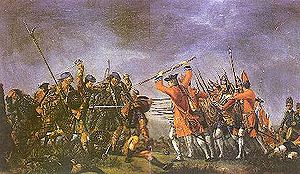
In 1603, Elizabeth I of England died. Thus James VI King of Scotland also became King James I of England. With the exception of a short period under The Protectorate, Scotland remained a separate state. There was considerable conflict between the crown and the Covenanters over the form of church government. After the Glorious Revolution and the overthrow of the Roman Catholic James VII by William and Mary, Scotland briefly threatened to select a different Protestant monarch from that of England. The Alien Act of 1705 was a law passed by the Parliament of England, in 1705, as a response to the Parliament of Scotland's Act of Security of 1704, which in turn was a response to the English Act of Settlement 1701.
The Alien Act provided that estates held by Scottish nationals in England were to be treated as alien property, making inheritance much less certain. It also had an embargo on the import of Scottish products into England and English colonies - about half of Scotland's trade, covering sectors such as linen, cattle and coal.
The Act contained a provision that it would be suspended if the Scots entered into negotiations on the dispute between the two parliaments. Combined with English financial offers to refund Scottish losses on the Darién scheme, it achieved its aim, leading to the Act of Union 1707 uniting the two countries as the Kingdom of Great Britain.
Jacobites
The deposed Jacobite Stuart claimants had remained popular in the Highlands and north-east, particularly amongst non-Presbyterians. Two major Jacobite risings launched from the Highlands of Scotland in 1715 and 1745. The latter uprising was lead by Bonnie Prince Charlie, aka "The Young Pretender". It climaxed with the defeat of the Jacobites at the Battle of Culloden on 16 April, 1746.
The Industrial Revolution
During the Scottish Enlightenment and the Industrial Revolution, Scotland became one of the commercial, intellectual and industrial powerhouses of Europe. After World War II, Scotland experienced an industrial decline.
Politics
Sovereign rule over Scotland rests with the government of the United Kingdom. The head of state is the British monarch, currently Queen Elizabeth II. The UK Parliament consists of two chambers: The House of Commons, an elected body; and the House of Lords, an appointed and partly hereditary body. Scotland is represented in the House of Commons by 59 MPs, each form single-member constituencies. Elections for MPs are held as part of the UK General Election every 4 or 5 years. Should a members seat become vacant between General Elections, for example if a member dies, then a By Election is held in that constituency to elect a new member.
The Scotland Office, a department of the United Kingdom government led by The Secretary of State for Scotland, is responsible for matters relating to Scotland that have not been devolved to the Scottish Parliament. The Secretary of State for Scotland has a seat on the Cabinet of the United Kingdom and the post is currently held by Douglas Alexander.
In the past, Scottish peers were entitled to elect sixteen representative peers to the House of Lords. In 1963, the Peerage Act was passed, allowing every Scottish peer to sit in the House of Lords. However, since recent reforms of the house, this is no longer the case. Hereditary Scottish peers have to stand for election from amongst all peers — Scottish, English, Welsh and Irish — who are eligible to sit.
The Act of Devolution 1997 created the Scottish Parliament and Scottish Executive. These bodies have control and legislative authority over many aspects of Scottish Politics including Health, Eduction,,,,,. Control over foreign affairs, military, broadcasting, and fiscal matters such as tax, among other things as set out in the Scotland Act 1998, remain with the UK government and parliament. The Scottish Parliament has limited power to vary income tax, but has not exercised this power to date. The programmes of legislation enacted by the Scottish Parliament have seen a divergence in the provision of public services compared to the rest of the United Kingdom. For instance, the costs of a university education, and care services for the elderly are free at point of use in Scotland, while fees are paid in the rest of the UK.
The Scottish Parliament is a unicameral legislature comprised of 129 Members. Members are elected in two ways. The 73 individual constituencies each elect a single member using a first past the post system. Another 56 members are elected by eight electoral regions via the additional member system. The Scottish Parliament was first elected on the 6th May 1999. The parliament serves for a four year period after which new elections are held. There is no limit on members standing for re-election.
The Scottish Executive, the executive arm of government, is lead by the First Minister. The post is appointed by the Queen, on the nomination of the Parliament. Other Ministers are also appointed by the Queen on the nomination of the Parliament. The current First Minister is Jack McConnell (since 2001) of the Labour Party, who forms the government through a coalition with the the Liberal Democrats. The main opposition party is the Scottish National Party, which campaigns for Scottish independence. Other parties include the Conservative and Unionist Party, the Scottish Green Party and the Scottish Socialist Party.
Scotland is sub devided, for local government, into 32 council areas. These were set up in 1996 following the Local Government etc. (Scotland) Act 1994. Each council is administered by a unitary authority responsible for the provision of all local government services including: education, social work, environment and roads services. Some of the larger Local councils are further divided into area committees known as Community councils. These are informal organisations that represent specific sub-divisions of a council area.
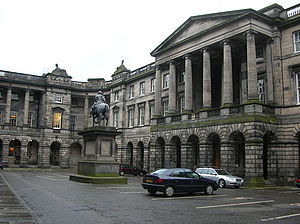
The terms of the Treaty of Union with England in 1707, guaranteed the continued existence of a separate legal system in Scotland from that of England and Wales. With a basis derived from Roman law, the Scots Law combines features of both an uncodified civil law, which dates back to the Corpus Juris Civilis,
along with common law built from mediaeval sources. Scotland still constitutes a discrete jurisdiction in public and in private international law.[11]. Prior to 1611, there were several regional law systems in Scotland, most notably Udal Law in Orkney and Shetland — based on Old Norse Law. Various other systems derived from common Celtic or Brehon Laws survived in the Highlands until the 1800s.
Scots law provides for three types of courts responsible for the administration of justice in Scotland: civil, criminal and heraldic. The supreme civil court is the Court of Session, although civil appeals can be taken to the House of Lords in London. The High Court of Justiciary is the supreme criminal court. Both courts are housed at Parliament House, Edinburgh which was the home of the pre-Union Parliament of Scotland. The sheriff court is the main criminal and civil court. There are 49 sheriff courts throughout the country.[12] District courts were introduced in 1975 for minor offences. The Court of the Lord Lyon regulates heraldry in Scotland.
- See also: Scots Law, Subdivisions of Scotland, and Scottish Parliament
Geography & Natural History
Scotland comprises the northern third of the island of Great Britain, which lies off the coast of north west Europe. The total land mass is 78,772 km² (30,414 mi²).[13] Scotland's only land border is with England, and runs for 96 kilometres (60 miles) between the River Tweed on the east coast and the Solway Firth in the west. The Atlantic Ocean borders the west coast and the North Sea is to the east. The island of Ireland lies only 30 kilometres (20 mi) from the south western peninsula of Kintyre, Norway is 400 kilometres (250 mi) to the north east, and the Faroes and Iceland are to the north.
The territorial extent of Scotland is generally that established by the 1237 Treaty of York between Scotland and England[14] and the 1266 Treaty of Perth between Scotland and Norway.[15] Exceptions include the Isle of Man, which is now a crown dependency outside the United Kingdom, and the 15th century acquisitions of Orkney and Shetland.[13]
Geology & Geomorphology
The whole of Scotland was covered by ice sheets during the Pleistocene ice ages and the landscape is much affected by glaciation. From a geological perspective the country has three main sub-divisions. The Highlands and Islands lie to the north and west of the Highland Boundary Fault, which runs from Arran to Stonehaven. This part of Scotland largely comprises ancient rocks from the Cambrian and Precambrian which were uplifted during the later Caledonian Orogeny. These foundations are interspersed with many igneous intrusions of a more recent age, the remnants of which have formed mountain massifs such as the Cairngorms and Skye Cuillins. A significant exception to the above are the fossil-bearing beds of Old Red Sandstones found principally along the Moray Firth coast. The Highlands are generally mountainous and are bisected by the Great Glen. The highest elevations in the British Isles are found here, including Ben Nevis, the highest peak at 1,344 metres (4,409 ft). Scotland has over 790 islands, divided into four main groups: Shetland, Orkney, and the Hebrides, sub-divided into the Inner Hebrides and Outer Hebrides. There are numerous bodies of freshwater including Loch Lomond and Loch Ness.
The Central Lowlands is a rift valley mainly comprising Paleozoic formations. Many of these sediments have economic significance for it is here that the coal and iron bearing rocks that fuelled Scotland's industrial revolution are to be found. This area has also experienced intense vulcanism, Arthur’s Seat in Edinburgh being the remnant of a once much larger volcano active in the Carboniferous period some 300 million years ago. Also known as the Midland Valley, this area is relatively low-lying, although even here hills such as the Ochils and Campsie Fells are rarely far from view.
The Southern Uplands are a range of hills almost 200 km (125 miles) long, interspersed with broad valleys. They lie south of a second fault line running from Stranraer towards Dunbar. The geological foundations largely comprise Silurian deposits laid down some 4-500 million years ago.[16][17][18]
Demographics
The population of Scotland in the 2001 census was 5,062,011. This has risen to 5,094,800 according to July 2005 estimates.[19] This would make Scotland the 112th largest country by population if it were a sovereign state. Although Edinburgh is the capital of Scotland it is not the largest city; Scotland's largest city, with a population of 629,501, is Glasgow. The highest concentration of population in Scotland is in the areas surrounding Glasgow with approximately 2.2 million people living in west central Scotland centred on the Greater Glasgow urban conurbation.[20][21] Scotland has the highest proportion of redheads of any country worldwide with around 13% of the population having naturally red hair. A further 40% of Scots carry the Mc1r variant gene which results in red hair.
Due to immigration since World War II, Glasgow, Edinburgh and Dundee have significant Asian and Scottish Asian populations.[22] Since the recent Enlargement of the European Union there has been an increased number of people from Central and Eastern Europe moving to Scotland. For example, Aleksander Dietkow, Consul General of Poland, estimates that there are between 40,000 and 50,000 Poles living in Scotland.[23] As of 2003, there are 16,315 Chinese people in Scotland and 18.2% of international students at Scottish Universities come from China, making them the largest international student group in Scotland.[24]
Languages
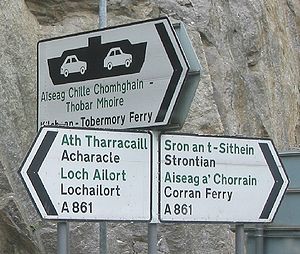
Scotland has three officially recognised languages: English, Scottish Gaelic and Scots. De facto Scottish Standard English is the main language spoken by the majority of people in Sctland. The General Register Office for Scotland estimates that 30% of the population are fluent in Scots, a sister language to Middel English. Over the past century the number of native speakers of Gaelic, has declined from around 5% to just 1% of the population. Gaelic is mostly spoken in the Western Isles.
Religion
The majority of people in Scotland describe themselves as Christian. Islam is the largest non-Christian religion in Scotland (estimated population, 50,000) despite accounting for less than 1% of the population.[25] There are also significant Jewish and Sikh communities, especially in Glasgow. At 28% of the population, Scotland has a high proportion of persons who regard themselves as belonging to 'no religion'. This was the second most common response in the 2001 census.[25]
Climate
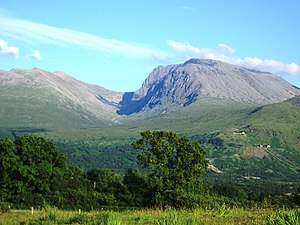
The climate of Scotland is temperate and oceanic, and tends to be very changeable. It is warmed by the Gulf Stream from the Atlantic, and as such has much milder winters (but cooler, wetter summers) than areas on similar latitudes, for example Oslo or Moscow. However, temperatures are generally lower than in the rest of the UK, with the coldest ever UK temperature of -27.2°C (-16.96°F) recorded at Braemar in the Grampian Mountains, on 11 February 1895 and 10 January 1982 and also at Altnaharra, Highland, on 30 December 1995. [26] Winter maximums average 6°C (42.8°F) in the lowlands, with summer maximums averaging 18°C (64.4°F). The highest temperature recorded was 32.9°C (91.22°F) at Greycrook, Scottish Borders on 9 August 2003. [27]
In general, the west of Scotland is usually warmer than the east, due to the influence of the Atlantic ocean currents, and the colder surface temperatures of the North Sea. Tiree, in the Inner Hebrides, is one of the sunniest place in the country: it had 300 days of sunshine in 1975. Rainfall varies widely across Scotland. The western highlands of Scotland are the wettest place, with annual rainfall exceeding 3,000 mm (120 inches).[27] In comparison, much of lowland Scotland receives less than 800 mm (31 inches) annually.[27] Heavy snowfall is not common in the lowlands, but becomes more common with altitude. Braemar experiences an average of 59 snow days per year,[28] while coastal areas have an average of fewer than 10 days.[27]
Flora and Fauna
Scotland's wildlife is typical of the north west of Europe although several of the larger mammals such as the brown bear, wolf and walrus were hunted to extinction in historic times. A population of wild cats remains.[29] There are important populations of seals and internationally significant nesting grounds for a variety of seabirds such as northern gannets.[30] The golden eagle is something of a national icon, and white-tailed eagles and ospreys are recent re-colonisations. The Scottish crossbill is Britain's only endemic bird.[31] The flora of the country is varied incorporating both deciduous and coniferous woodlands, and moorland and tundra species. Significant remnants of the native Scots Pine forest, can be found in places.[32]
Scotland comprises the northern third of the island of Great Britain, off the coast of north west Europe. The total land mass is around 78,772 square kilometres (30,414 mi²). Scotland's only land border is with England, and runs for 96 kilometres (60 miles) between the River Tweed on the east coast and the Solway Firth in the west. The island of Ireland lies around 30 kilometres (20 mi) off the south west tip of Scotland, Norway is around 400 kilometres (250 mi) to the north east, and the Faroes and Iceland lie to the north. Scotland is bounded by the North Sea to the east, the Atlantic Ocean to the north and west, and the North Channel and Irish Sea to the southwest.
The territorial extent of Scotland is generally that established by the 1237 Treaty of York between Scotland and England and the 1266 Treaty of Perth between Scotland and Norway. Exceptions include the Isle of Man, which is now a crown dependency outside the United Kingdom, Orkney and Shetland, which are Scottish rather than Norwegian, and Berwick-upon-Tweed, which was defined as subject to the laws of England by the 1746 Wales and Berwick Act. Rockall was annexed by the United Kingdom in 1972 and administratively made part of the Isle of Harris in Scotland, although this is disputed by the Republic of Ireland, Iceland, and Denmark; both the UK (in 1997) and Ireland (in 1996) have since ratified the United Nations Convention on the Law of the Sea, which excludes Rockall from qualifying as land from which various territorial limits can be measured although it is claimed by both the UK and Ireland that it lies within their territorial limits.
The country consists of a mainland area plus several island groups. The mainland can be divided into three areas: the Highlands in the north; the Central Belt and the Southern Uplands in the south. The Highlands are generally mountainous and are bisected by the Great Glen. The highest mountains in the British Isles are found here, including Ben Nevis, the highest peak at 1,344 metres (4,409ft). All mountains over 3,000 ft (914 m) are known as Munros. The Central Belt of Scotland is generally flat and is where most of the population reside. The Central Belt is often divided into the West, which contains the areas around Glasgow; and the East which includes the areas around the capital, Edinburgh. The Southern Uplands are a range of hills and mountains almost 200 km (125 miles) long, stretching from Stranraer by the Irish Sea to East Lothian and the North Sea.
Scotland has over 790 islands, divided into several main groups: Shetland, Orkney, and the Hebrides — which can be sub-divided into the Inner Hebrides and Outer Hebrides. The Firth of Clyde and the Firth of Forth also contain many islands. St. Kilda is the most remote of all the inhabitable Scottish islands, being over 160 km (100 miles) from the mainland. Almost all the islands surrounding Scotland, no matter how small or remote, were formerly inhabited, as is shown by archaeological and documentary evidence. In general only the more accessible and larger islands retain human populations (though these are in some cases very small). Access to several islands in the Northern and Western groups was made easier in the course of the 20th century by the construction of bridges or causeways (e.g., the Churchill Barriers), installed for strategic reasons during the Second World War between several small islands on the east side of Scapa Flow in Orkney. Plans, some controversial, for more links between islands continue to be drawn up.
Economy
The Scottish economy is closely linked with that of the rest of Europe and the wider Western world, with a heavy emphasis on exporting. It is essentially a market economy with some government intervention. After the Industrial Revolution, the Scottish economy concentrated on heavy industry, dominated by the shipbuilding, coal mining and steel industries. Scotland was an integral component of the British Empire which allowed the Scottish economy to export its output throughout the world.
Heavy industry declined, however, in the later part of the 20th century, leading to a remarkable shift in the economy of Scotland towards a technology and service sector-based economy. The 1980s saw an economic boom in the Silicon Glen corridor between Glasgow and Edinburgh, with many large technology firms relocating to Scotland. The discovery of North Sea oil in the 1970s also helped to transform the Scottish economy.
Edinburgh is the financial services centre of Scotland and the sixth largest financial centre in Europe,[33] with many large finance firms based there, including: the Royal Bank of Scotland Group (the second largest bank in Europe); HBOS (owners of the Bank of Scotland); Standard Life; and Scottish Widows.
Glasgow is Scotland's leading seaport and is the fourth largest manufacturing centre in the UK, accounting for well over 60% of Scotland's manufactured exports. Shipbuilding, although significantly diminished from its heights in the early 20th century, still forms a large part of the city's manufacturing base. The city also has Scotland's largest and most economically important commerce and retail district. Glasgow is also one of Europe's top 20 financial centres and is home to many of the UK's leading companies.
Aberdeen, sometimes referred to as the Oil Capital of Europe, is the centre of the North Sea oil industry. Other important industries include textile production, chemicals, distilling, brewing, fishing and tourism.
Only about one quarter of the land is under cultivation (principally in cereals and vegetables). sheep farming is important in the less arable highland and island regions. Most land is concentrated in relatively few hands (some 350 people own about half the land). As a result, in 2003, the Scottish Parliament passed the Land Reform (Scotland) Act 2003 that empowers tenant farmers and local communities to purchase land even if the landlord does not want to sell.
In 2004, total Scottish exports (excluding intra-UK trade) were provisionally estimated to be £16.7 billion, of which 73% (£12.19 billion) were attributable to manufacturing. The largest export products for Scotland are niche products such as whisky, electronics and financial services. The largest export markets were the United States, Germany, and The Netherlands.[34] In 2002, the Gross Domestic Product (GDP) of Scotland was just over £74 billion ($130 billion), giving a per capita GDP of £14,651 ($25,546).[35]
Although the Bank of England is the central bank for the UK, three Scottish clearing banks still issue their own Sterling banknotes: the Bank of Scotland; the Royal Bank of Scotland; and the Clydesdale Bank. These notes have no status as legal tender in England, Wales, or Northern Ireland, although they are fungible with the Bank of England banknotes. Despite this, Scottish-issued notes are often refused in England and they are not always accepted by banks and exchange bureaus outside the UK. The current value of the Scottish banknotes in circulation is around £2.5 billion.
Education
The education system in Scotland is distinct from the rest of the United Kingdom. Scotland was the first country since Sparta in classical Greece to implement a system of general public education. The early roots were in the Education Act of 1496 which first introduced compulsory education for the eldest sons of nobles. Then, in 1561, the principle of general public education was set with the Reformation establishment of the national Kirk which set out a national programme for spiritual reform, including a school in every parish. Education finally came under the control of the state rather than the Church and became compulsory for all children from the implementation of the Education Act of 1872 onwards. As a result, for over two hundred years Scotland had a higher percentage of its population educated at primary, secondary and tertiary levels than any other country in Europe. The differences in education have manifested themselves in different ways, but most noticeably in the number of Scots who went on to become leaders in their fields and at the forefront of innovation and discovery leading to many Scottish inventions during the 18th and 19th centuries.
Today, children in Scotland sit Standard Grade exams at the age of 15 or 16, sometimes earlier, for up to eight subjects (although some schools study for nine) including compulsory exams in English, mathematics, a foreign language, a science subject and a social subject. Each school may vary these compulsory combinations. The school leaving age is 16, after which students may choose to remain at school and study for Access, Intermediate or Higher Grade and Advanced Higher exams. A small number of students at certain private, independent schools may follow the English system and study towards GCSEs instead of Standard Grades, and towards A and AS-Levels instead of Higher Grade and Advanced Higher exams.
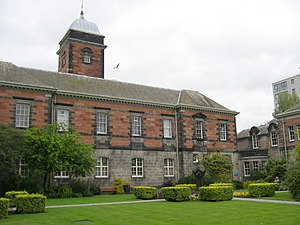
The Scottish Executive funds over forty further and higher education colleges where students can study for more vocational qualifications; degree-entry qualifications such as diplomas; and specialist courses in the arts or agriculture. Scotland has 13 universities and one university college, including the four ancient universities of Aberdeen, Edinburgh, Glasgow and St Andrews founded during the mediaeval period. Bachelor's degrees at Scottish universities are bestowed after four years of study, with the option to graduate with an ordinary degree after three years or continue with the fourth year of study to obtain an honours degree. Unlike the rest of the United Kingdom, Scottish students studying at a Scottish university do not have to pay for tuition fees. The Students Awards Agency for Scotland (SAAS) pay course fees for all Scottish students domiciled in Scotland and offer bursaries to eligible students. Scottish students have the option of accepting a loan from the Student Loans Company (SLC), and if eligible, this is paid back after graduation. Scottish students studying outside of Scotland but within the UK have to pay for tuition, but at a reduced rate depending upon how much their chosen institution charges. All Scottish universities attract a high percentage of overseas students, and many have links with overseas institutions.
Culture
The culture of Scotland, although heavily influenced by that of neighbouring England is distinct and internationally recognisedTemplate:Fact. Scotland has its own arts scene with both music and literature heavily influenced by unique Scottish sources and some Scottish sporting traditions are unique to the British Isles.
Languages
Scots and Gaelic were recognised under the European Charter for Regional or Minority Languages ratified by the UK in 2001, and the Scottish Executive is committed, based on the UK's undertakings, to providing support for both[36] Under the Gaelic Language (Scotland) Act 2005 which was passed by the Scottish Parliament to provide a statutory basis for a limited range of Gaelic language service provision, English and Gaelic receive "equal respect" but do not have equal legal status.[37] State support for Scots is slowly growing with the Scottish Executive providing some funding to various Scots language projects and bodies, including the Dictionary of the Scots Language.
Religion
The Church of Scotland, also sometimes popularly known as The Kirk, is the national church and has a Presbyterian system of church government. It is not subject to state control nor is it "established" as is the Church of England within England. It was formally recognised as independent of the UK Parliament by the Church of Scotland Act 1921, settling centuries of dispute between church and state over jurisdiction in spiritual matters.
The Scottish Reformation, initiated in 1560 and led by John Knox, was Calvinist, and throughout the 17th and 18th centuries, the Church of Scotland maintained this theology and kept a tight control over the morality of much of the population. The Church had a significant influence on the cultural development of Scotland in early modern times. Other Christian denominations in Scotland include the Free Church of Scotland, an off-shoot from the Church of Scotland adhering to a more conservative style of Calvinism, the Scottish Episcopal Church, which forms part of the Anglican Communion, the Methodists, the Congregationalists, and The Church of Jesus Christ of Latter-day Saints.
Roman Catholicism in Scotland survived the Reformation, especially on islands like Uist and Barra, despite the suppression of the 16th to the late 18th centuries. Roman Catholicism was strengthened particularly in the west of Scotland during the 19th century by immigration from Ireland. This continued for much of the 20th century, during which significant numbers of Catholics from Italy and Poland also migrated to Scotland. Much of Scotland (particularly the West Central Belt around Glasgow) has experienced problems caused by sectarianism, particularly football rivalry between the traditionally Roman Catholic team, Celtic, and the traditionally Protestant team, Rangers.
Cuisine
Scottish cuisine has much in common with others in the UK, but has distinctive attributes and recipes of its own, thanks to foreign and local influences both ancient and modern. Traditional dishes exist alongside international foods brought by immigration and a Scottish public eager to try new dishes. The national food of Scotland is Haggis, which consists of minced offal, spices, suet and oatmeal, stuffed and cooked in a sheep's stomach.
Scottish cuisine is enjoying a renaissance, with a number of Michelin star restaurants operating in the country, serving traditional or fusion Scottish cuisine made with local ingredients. In most towns, Chinese and Indian take-away restaurants exist side-by-side with traditional fish and chip shops; larger towns and cities offer cuisine ranging from Thai and Japanese to Mexican.
Music
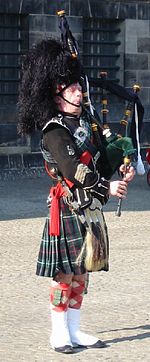
The Scottish music scene is a significant aspect of Scottish culture, with both traditional and modern influences. An example of a traditional Scottish instrument is the Great Highland Bagpipe, a wind instrument consisting of one or more musical pipes which are fed continuously by a reservoir of air in a bag. The Clàrsach, fiddle and accordion are also traditional Scottish instruments, the latter two heavily featured in Scottish country dance bands. Scottish emigrants took traditional Scottish music with them and it influenced early local styles such as country music in North America. Today, there are many successful Scottish bands[38] and individual artists in varying styles.
Literature
Scottish literature includes literature written in English, Scottish Gaelic, Scots, Brythonic, French, Latin and any other language in which a piece of literature was ever written within the boundaries of modern Scotland. Some of the earliest literature known to have been composed in Scotland dates from the 6th century and includes Y Gododdin written in Brythonic (Old Welsh) and the Elegy for St Columba by Dallan Forgaill written in Middle Irish. Vita Columbae by Adomnán, the ninth Abbot of Iona, was written in Latin during the 7th century. In the 13th century, French flourished as a literary language long before Early Scots texts appeared in the fourteenth century. After the 17th century, anglicisation increased, though Lowland Scots was still spoken by the vast majority of the population of the Lowlands. The poet and songwriter Robert Burns wrote in the Scots language, although much of his writing is also in English and in a "light" Scots dialect which would have been accessible to a wider audience than simply Scottish people.
The introduction of the movement known as the "kailyard tradition" at the end of the 19th century, brought elements of fantasy and folklore back into fashion. J. M. Barrie provides a good example of this mix of modernity and nostalgia. This tradition has been viewed as a major stumbling block for Scottish literature, focusing, as it did, on an idealised, pastoral picture of Scottish culture, becoming increasingly removed from reality of life in Scotland during that period. Some modern novelists such as Irvine Welsh, (of Trainspotting fame), write in a distinctly Scottish English that reflects the underbelly of contemporary Scottish culture.
Sport
Scotland has its own national governing bodies, such as the Scottish Football Association (the second oldest national football association in the world)[39] and the Scottish Rugby Union; and its own national sporting competitions. As such, Scotland enjoys independent representation at many international sporting events such as the FIFA World Cup, the Rugby World Cup and the Commonwealth Games; although notably not the Olympic Games.
Variations of football have been played in Scotland for centuries with the earliest reference being in 1424.[40] Association football is now the national sport but earlier versions such as the ba game are still played. Scotland hosted the first ever international rugby union match in 1871[41] and 20 months later followed with the first ever international association football match. Both were played against England with the rugby union side winning and the association side drawing. The Scottish Cup is the world's oldest national trophy.Template:Fact
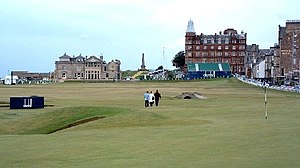
The Fife town of St Andrews is known internationally[42] as the Home of Golf. To many people, the Old Course at St Andrews, an ancient links course dating to before 1574, may be considered a site of pilgrimage.[43] There are many other famous golf courses in Scotland, including Carnoustie, Gleneagles, Muirfield and Royal Troon.
Other distinctive features of the national sporting culture include the Highland Games, curling and shinty. Kingussie Camanachd, the dominant shinty team, is recognised by Guinness World Records as the most successful sporting club team in the world. Scotland has several ski resorts. These are Cairn Gorm, Glen Coe, Glen Shee, The Lecht, and Nevis Range. Scotland also hosts snowboarding and most other winter sports.
Media
The national broadcaster is BBC Scotland (BBC Alba in Gaelic), a constituent part of the British Broadcasting Corporation, the publicly-funded broadcaster of the United Kingdom. It runs two national television stations and the national radio stations, BBC Radio Scotland and BBC Radio nan Gaidheal amongst others. The main Scottish commercial television station is stv. Border TV, based in Cumbria in England, broadcasts in Dumfries and Galloway and the Scottish Borders. There are also a number of independent local radio stations throughout the country, the largest of which are Clyde 1 and Forth One. Although BBC Scotland and commercial stations broadcast mainly in English, they also have some segments in Gaelic. Tele-G is the only Gaelic language television channel; it broadcasts from 6-7pm every day on the Freeview platform.
The news media is distinct with broadcast television programmes including the BBC's Reporting Scotland and Newsnight Scotland, as well as regional programmes like stv's Scotland Today and North Tonight. National newspapers such as the Daily Record (Scotland's leading tabloid), The Herald, and The Scotsman are all produced in Scotland. Regional dailies include The Courier in Dundee in the east, and The Press and Journal serving Aberdeen and the north.
Transport

Scotland has four main international airports (Glasgow, Edinburgh, Prestwick and Aberdeen) that serve a wide variety of European and intercontinental routes with scheduled and chartered flights. Highland and Islands Airports operate 10 regional airports serving the more remote locations of Scotland.[44] There is technically no national airline, however various airlines have their base in Scotland including Loganair (operates as a franchise of British Airways), Flyglobespan, City Star Airlines, Air Scotland and ScotAirways.
Scotland has a large and expanding rail network, which, following the Railways Act of 2005, is now managed independently from the rest of the UK.[45] The East Coast and West Coast Main Railway lines and the Cross Country Line connect the major cities and towns of Scotland with the English network. First ScotRail operate services within Scotland. The Scottish Executive has pursued a policy of building new railway lines, and reopening closed ones.
The Scottish motorways and major trunk roads are managed by the Scottish Executive. The rest of the road network is managed by the Scottish local authorities in each of their areas. The country's busiest motorway is the M8 which runs from the outskirts of Edinburgh to central Glasgow, and on to Renfrewshire.
Regular ferry services operate between the Scottish mainland and island communities. These services are mostly run by Caledonian MacBrayne, but some are operated by local councils. Other ferry routes, served by multiple companies, connect to Northern Ireland, Belgium, Norway, the Faroe Islands and also Iceland.
Notes
- ↑ The website of the Prime Minister of the United Kingdom refers to "Countries within a country", stating "The United Kingdom is made up of four countries: England, Scotland, Wales and Northern Ireland".
- ↑ Scottish Executive Resources. Scotland in Short. Retrieved on September 14, 2006.
- ↑ Edinburgh, Inspiring Capital - Information for Journalists - "Edinburgh is Europe's sixth largest fund management centre".
- ↑ Image showing 1999 Scottish Fishing and Territorial Waters www.opsi.gov.uk
- ↑ . Edinburgh. By Neil Wilson, Tom Smallman: Page 76 Scotland. By Neil Wilson, Alan Murphy: Page 72 Scotlandspast.org - "Radiocarbon dating of carbonised hazelnut fragments found at the site confirmed that Cramond is the earliest Mesolithic site in Scotland, dating back to between 8500 and 8250 BC (calibrated)."
- ↑ Harvie, Christopher T. Scotland: A Short History, Page 13.
- ↑ Though he did not arrive untill the summer of 78.
- ↑ The Anglo-saxon Chronicle. By Darryl Hester, James Ingram (Translator), James Ingram: Page 86.
- ↑ The Spottiswoode Miscellany: a collection of original papers and tracts, illustrative chiefly of the Civic and Ecclesiastical history of Scotland. By James Maidment - 1844: Page 444 to 445.
- ↑ The Wordsworth Dictionary of British History. By J. P. (John Philipps) Kenyon, Norman Stone: Page 228.
- ↑ pdf file "For the purposes of the English conflict of laws, every country in the world which is not part of England and Wales is a foreign country and its foreign laws. This means that not only totally foreign independent countries such as France or Russia... are foreign countries but also British Colonies such as the Falkland Islands. Moreover, the other parts of the United Kingdom - Scotland and Northern Ireland - are foreign countries for present purposes, as are the other British Islands, the Isle of Man, Jersey and Guernsey." Conflict of Laws, JG Collier, Fellow of Trinity Hall and lecturer in Law, University of Cambridge
- ↑ Scottish Court Information www.scotcourts.gov.uk
- ↑ 13.0 13.1 Whitaker's Almanack (1991) London. J. Whitaker and Sons.
- ↑ National Archives. [1] Retrieved 21.11.06
- ↑ Mackie, J.D. (1969) A History of Scotland. London. Penguin.
- ↑ Keay, J. & Keay, J. (1994) Collins Encyclopaedia of Scotland. London. HarperCollins.
- ↑ Murray, W.H. (1973) The Islands of Western Scotland. London. Eyre Methuen
- ↑ Murray, W.H. (1977) The Companion Guide to the West Highlands of Scotland. London. Collins.
- ↑ Scotland's Population rises for the third year in a row. General Register Office for Scotland April 2006
- ↑ Strathclyde Passenger Transport With a population of 2.2 million West Central Scotland accounts for almost half of Scotland's population
- ↑ TalentScotland, Scottish Enterprise More than 2.2 million people live in the Strathclyde area, which includes Greater Glasgow, Scotland’s largest conurbation
- ↑ Urdustan. net 2004 Scotland speaks Urdu
- ↑ Sunday Herald August 6, 2005 The Pole Position
- ↑ Scottish Executive, International Relations International Relations, Increase Student flows between Scotland and China
- ↑ 25.0 25.1 General Register Office for Scotland 2001 Census analysis
- ↑ BBC Weather Features UK Records UK Records
- ↑ 27.0 27.1 27.2 27.3 Met Office. Met Office - Details for Scotland. Retrieved on September 14, 2006.
- ↑ BBC Weather features Scottish Weather Part One
- ↑ Matthews, L.H. (1968) British Mammals. London. Bloomsbury.
- ↑ Fraser Darling, F. & Boyd, J.M. (1969) Natural History in the Highlands and Islands. London. Bloomsbury.
- ↑ Gooders, J. (1994) Field Guide to the Birds of Britain and Ireland. London. Kingfisher.
- ↑ Preston, C.D., Pearman, D.A., & Dines, T.D. (2002) New Atlas of the British and Irish Flora. Oxford University Press.
- ↑ Milner M. and Treanor J.. Devolution may broaden financial sector's view, The Guardian, 1999-06-02. Retrieved on 2006-08-08. (in English)
- ↑ The Scottish Executive (June 2006). The Scottish Economic Report June 2006 (Template:PDFlink). The Scottish Executive. Retrieved on 2006-08-08.
- ↑ The Scottish Executive (2006). Scottish Economic Statistics. The Scottish Executive. Retrieved on 2006-08-08.
- ↑ European Charter for regional or minority languages www.scotland.gov.uk
- ↑ MSPs rule against Gaelic equality BBC Online, 21 April 2005
- ↑ Best Scottish Band of All Time. Retrieved on 2006-08-02.
- ↑ Soccer in South Asia: Empire, Nation, Diaspora. By James Mills, Paul Dimeo: Page 18 - Oldest Football Association is England's FA, then Scotland and third oldest is the Indian FA.
- ↑ Gerhardt, W.. The colourful history of a fascinating game. More than 2000 Years of Football. FIFA. Retrieved on August 11, 2006.
- ↑ Sport and International Politics. By Pierre: Page 22.(EDT) Arnaud, James (EDT) Riordan
- ↑ TALES from PINEHURST: Stories from the Mecca of American Golf. By Robert Hartman: Page 89.
- ↑ Science and Golf IV: proceedings of the World Scientific Congress of Golf. By Eric Thain: Page 849.
- ↑ Informational Site of Highlands and Islands Airports
- ↑ Transport Scotland, Official transportation site of the Scottish Executive
References
- ???, Scottish Population History from the 17th Century to the 1930s, CUP 1977
- Burleigh, J., A Church History of Scotland
- Smout, T.C., A History of the Scottish People, Fontana 1969
- Spottiswood, J., The history of the Church of Scotland
- Wormald, J., The New History of Scotland',' London 1981
- (PDF file) Scottish economic statistics 2005 - from the Scottish Executive
- Scottish Census Results On Line - official government site for Scotland's census results
- Scottish Neighbourhood Statistics - Scottish Executive's programme of small area statistics in Scotland
External links
- Scottish Tourist Board - official site of Scotland's national tourist board, VisitScotland
- Maps and digital collections at the National Library of Scotland
- The Gazetteer for Scotland - Extensive guide to the places and people of Scotland, by the Royal Scottish Geographical Society and University of Edinburgh
